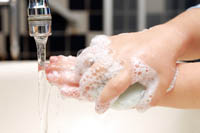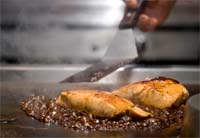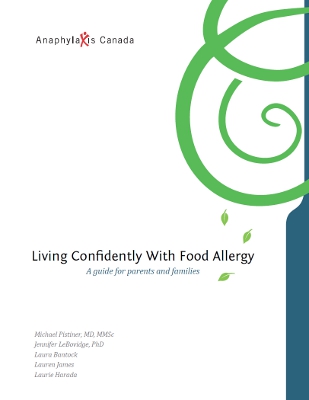Oral ingestion (mouth)

Skin contact (touch)

Inhalation (breathing in)
- In steam from cooking food (e.g. sizzling fish)
- When food in a powdered form is released into the air (e.g. blowing powdered milk)
- When small amounts get into the air when food is crushed or ground (e.g. tree nuts). 8
These reactions are usually mild, but in rare cases people have had severe reactions.6 8 11


- Wash your hands before eating or touching your nose, eyes or mouth.
- Only eat food that is made for you. It’s not safe to share food.
- Don’t share spoons, forks, knives, cups, bottles or straws.
- If you get an allergen on your skin, ask an adult for help, clean it off and wash your hands.
 Make hand-washing fun for young kids – sing a song that lasts about 30 seconds.
Make hand-washing fun for young kids – sing a song that lasts about 30 seconds.
5. Maloney, J.M., Chapman, M.D., and Sicherer, S.H. “Peanut allergen exposure through saliva: Assessment and interventions to reduce exposure.” The Journal of Allergy and Clinical Immunology 118.3 (2006): 719-724.
6. Simonte, S.J. et al. “Relevance of casual contact with peanut butter in children with peanut allergy.” The Journal of Allergy and Clinical Immunology 112.1 (2003): 180-182.
7. Wainstein, B.K. et al. “Combining skin prick, immediate skin application and specific-IgE testing in the diagnosis of peanut allergy in children.” Pediatric Allergy and Immunology 18 (2007): 231–239.
8. Kim, J.S. and Sicherer, S.H. “Living with Food Allergy: Allergen Avoidance.” Pediatric Clinics of North America 58.2 (2011): 459-470.
9. Tulve, N. et al.“Frequency of mouthing behavior in young children.” Journal of Exposure Analysis and Environmental Epidemiology 12 (2002): 259–264.
10. Nicas, M., and Best, D.J. “A study quantifying the hand-to-face contact rate and its potential application to predicting respiratory tract infection.” Journal of Occupational Environmental Hygiene 5.6 (2008): 347-52.
11. Roberts, G., Golder, N. and Lack, G. “Bronchial challenges with aerosolized food in asthmatic, food-allergic children.” Allergy 57.8 (2002): 713-7.
